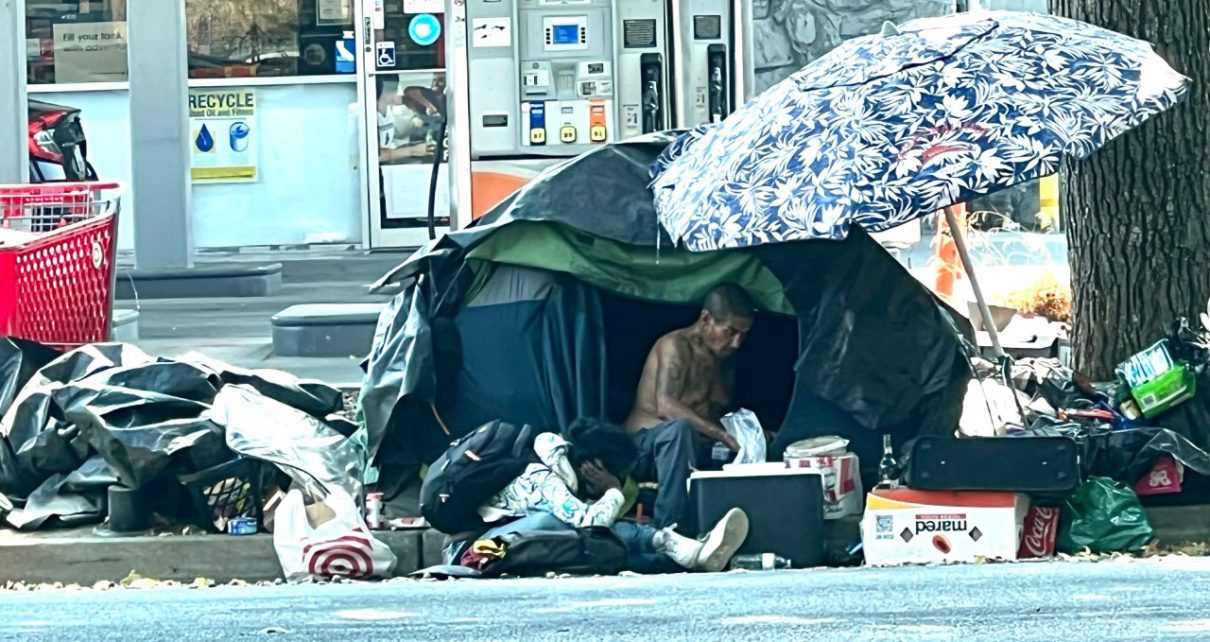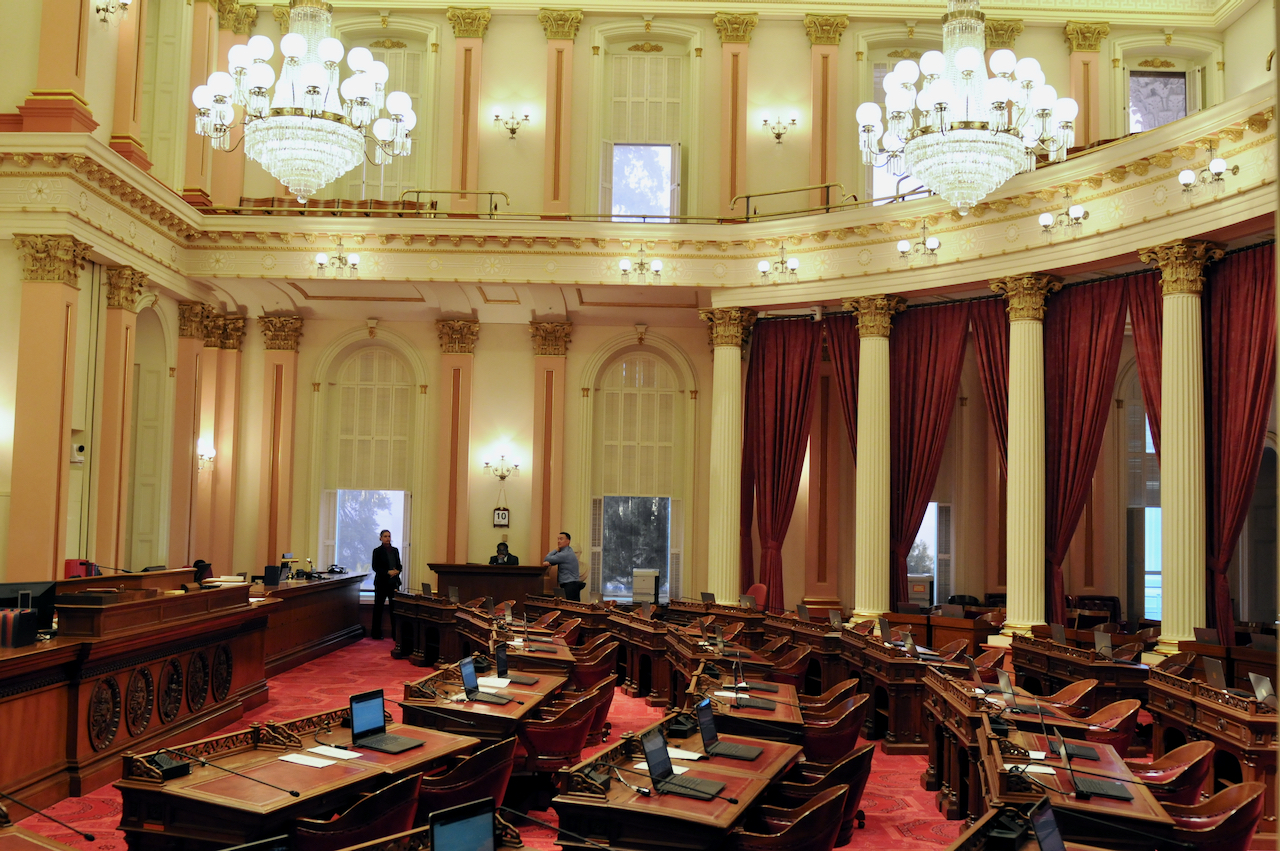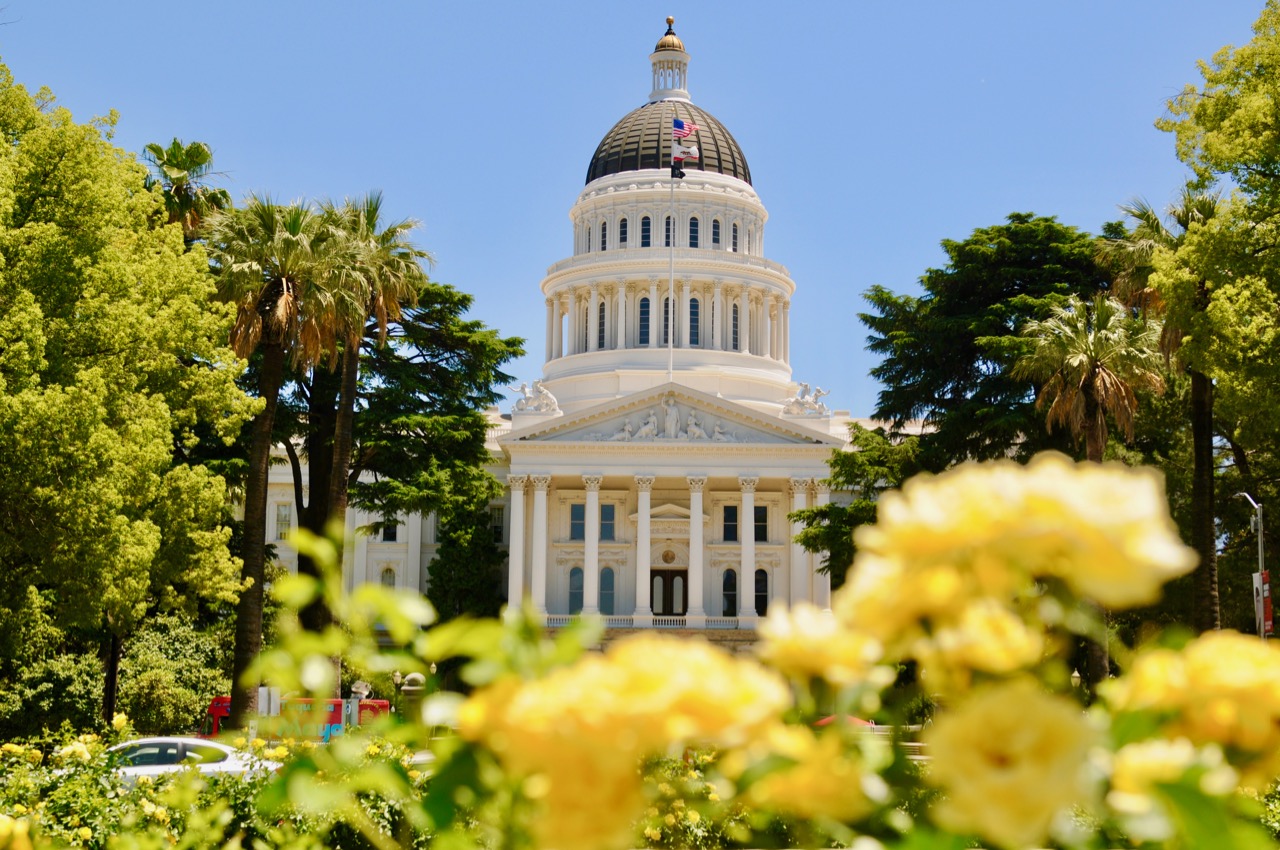
Homeless transient living on sidewalk at Union 76 gas station, W Street, 16th Street. (Photo: Katy Grimes for California Globe)
California State Auditor’s Scathing Homeless Report: Where Did the Money Go?
The homeless-industrial complex – which stands between the state and the homeless person – is hoovering up vast amounts of cash with little or no oversight
By Thomas Buckley, April 10, 2024 7:41 am
The California State Auditor yesterday issued a scathing report on how very broken are the state’s homeless programs.
In the last five years, the state has spent about $24 billion dollars trying to eradicate – or at least lessen – California’s enormous homelessness problem. Currently, there are about 183,000 homeless people in the state: that’s up 53% in the past ten years and 30% in just the last five.
That puts the average annual spending per homeless person at about $30,000 and that figure does not necessarily include local programs. For example, this fiscal year alone Los Angeles will spend another $1.3 billion – about another $19,000 per person – on top of the state money while other cities will do much the same. The LA figure does not include the billions set aside in bond money to build “permanent housing,” housing that it is coming in at a clip of about $750,000 per unit for what is essentially a studio apartment.
Unquestionably, as the spending around the state has gone so has the homeless population. What is also unquestionable, according to the audit, is the fact that the state isn’t really sure how it is money is being spent.
In theory the California Interagency Council on Homelessness is supposed to oversee the labyrinth of homeless service programs. There are literally hundreds of “continuum of care” organizations – from government agencies to non-profits to the financial netherworld in between, see the HOPICS disaster in LA.
But the audit found that the Council is not accurately tracking a number of critical items, specifically, whether or not any of the programs it funds actually reduce homelessness.
“(The council) has not tracked and reported on the State’s funding for homelessness programs statewide since its 2023 assessment covering fiscal years 2018–19 through 2020–21. Currently, it has no plans to perform a similar assessment in the future. In the absence of an uptodate assessment, the State and its policymakers are likely to struggle to understand homelessness programs’ ongoing costs and achieved outcomes,” reads the report. “(It) has neither ensured the accuracy of the information in the state data system, nor has it used this information to evaluate homelessness programs’ success.”
There is of course the possibility that the Council does not do an effective job of tracking funding and outcomes because they do not really want to know – nor do they want the public to know – how much of a failure their efforts have been, but that seems a tad too cynical, considering Sacramento’s reputation for probity and transparency.
A pair of examples given in the audit stand out. First, in looking through various programs, the auditors found “more than 100 enrollment records with client names such as ‘Mickey Mouse,’ ‘Super Woman,’ or a name indicating it was a test client, such as ‘Test Participant.’”
One can assume that that program’s Wi-Fi password was “guest.”
In another example, “a shelter reported nearly 1,100 people enrolled in fewer than 300 beds. When we asked about these entries, (council) staff explained that enrollment records do not always show when individuals stopped receiving services. As a result of these errors, some of the enrollment numbers we present in this report may be overstated.”
In other words, a bass ackwards “Hotel California” : You can leave anytime you want, but you can never check out.
The audit did opine that Project Homekey is, compared to other costs of permanent housing, at least financially more responsible, with it’s conversion units (think old motels) coming in at about $144,000 each around the state compared to an average of $480,000 per unit for new construction Note – that number is a statewide average – in Los Angeles the number is about double that.
Besides the meandering money trail, there is the issue of program effectiveness.
From 2019 to March of last year, the audit found that 274,000 homeless people had entered “interim shelter” while about 46,000 had entered a more permanent situation.
In that same period, 248,000 people exited interim shelter – the numbers are not the same because “Some placements of individuals showed that the person had not yet exited the program and was still enrolled and receiving shelter or housing services as of the date we obtained the data.”
Oops.
Of those exiting, 44% went back to homelessness. 24% found some type of shelter, and about 32% were listed as “other.”
Considering the definition of other – worker unable to determine, client doesn’t know, client prefers not to answer, data not collected, or other – it seems to be a good bet that they, for the most part, are homeless as well.
On the flip side, those homeless that went down the “permanent shelter” path did better, with only about 10%, the audit states, going back on the streets (note – that number may be higher as, again, the tracking of people was not exactly perfect.)
The entire audit can be found here and is surprisingly clear for a government document.
And the conclusions is clear as well – the state is spending money faster than it can track it, that the money being spent is exorbitant, that spending money on homelessness, at least in California, actually increases the problem due to the induced demand (people from out of state coming for the benefits and yes it is a very high percentage,) and that the homeless-industrial complex – which stands between the state and the homeless person – is hoovering up vast amounts of cash with little or no oversight.
Nice work if you can get it Evil, but nice.
- Abort Last Week: Gov. Newsom Actually Promoting Abortion - April 29, 2024
- ADA Diana Teran Booked, Los Angeles DA Gascon Faces Another Complaint - April 28, 2024
- Curiouser and Curiouser: Gascon’s Aide Charges Raise Troubling Issues - April 27, 2024





And yet Gavin wanted more $$ with Prop 1. I am glad there was a fight, and it was basically 50/50 in a heavy-leaning liberal state but bummed that LA and the Bay Area shoved it over the finish line. Zero faith that CA will use the new funds properly. Zero faith.
As Ms. Grimes said, live on Fox Business, Varney & Company, “It’s Crazifornia. Anything can happen.” This is what a one-party controlled state becomes. There is also little to no accounting of the Covid relief funds given to the state and distributed by Newscum (this is what Mr. Trump calls the governor now). Will voters ever learn? Will it matter if they do – with all the election cheating and universal mail-in ballots?
Here is Katy Grimes’ appearance yesterday morning on Fox Business, Varney & Company:
“We call it ‘Crazy-fornia’ for a reason”
https://www.youtube.com/watch?v=fdhZtJDUa_E&list=PLv1qHE0zuJL_td8fvTAPke5WAv2Dk0LoF&index=1
Thank you for the link @Show.
I agree with everyone, these guys and gals should be held accountable.
The city I live in has an increase in the homeless population. The county buys the “unhoused”
salvaged RV’s and parks them in the industrial area, soon they will run out of streets. Do you think this qualifies as permanent housing?😏
Success!!
The Cali Dems are basically a white-collar criminal organization, if the federal DOJ wasn’t so corrupt and sympathetic to them, there would be a huge investigation.
Amen, DB Holly – RICO for sure.
They deserve to locked up, for sure, and do significant time in prison, and the day must be coming that they will be. Gavin Newsom himself is always blathering about “accountability, accountability, accountability.” Okay, great, let’s SEE some, Newsom. You first.
This is a bigger fraud than anything that Sam Bankman Fried guy could have ever devised in his wildest dreams!
Why is no one in jail for this?
More CA fraud, bloat, and waste
this was just another channel to send money to payback campaign donors – its a vicious circle of grifting among the elite – we pay the repercussions
The answer regarding where the money is going is straightforward. It’s going to the politicians’ buddies and cronies in the Homeless Industrial Complex. The Complex intentionally fails so it can continue to ask for more money to solve the homeless (“unhoused”, “houseless”) problem.
YUP!
The criminal Democrat mafia that controls California blew through $24 Billion and the homeless problem has only gotten worse? No doubt it’s a money laundering operation for them?
Sure looks like it’s that too!
If government actually wanted to help instead of paying the homeless cartel, they would issue more housing vouchers with a few tweaks to make them actually work. Lots cheaper than the current programs, and any who are homeless mainly due to finances and not other issues would get real housing instead of a more costly shelter bed. The main thing that would make vouchers work is if government served as a cosigner. Not just for the rent, but as importantly for damages and legal costs. Landlords do not want to take a chance on the homeless due to some of them being destructive slobs who won’t even take out the trash. That may not be PC to say, but for vouchers to work the program needs changes.